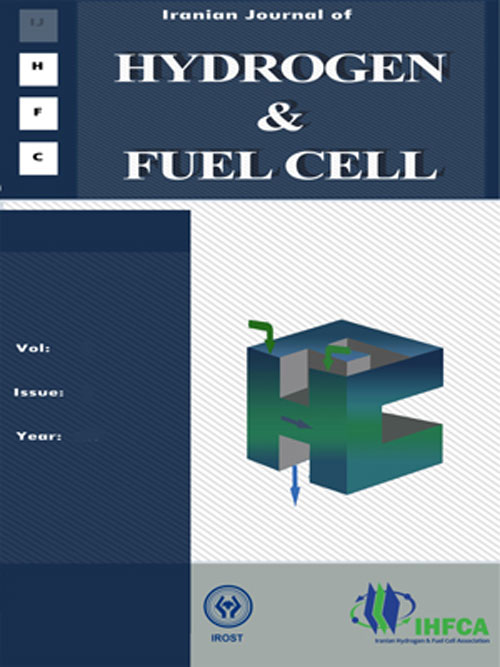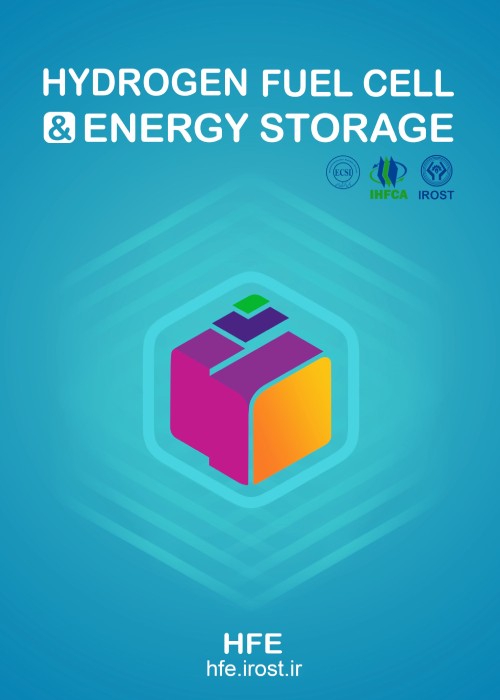فهرست مطالب

Journal of Hydrogen, Fuel Cell and Energy Storage
Volume:2 Issue: 4, Autumn 2015
- تاریخ انتشار: 1394/10/09
- تعداد عناوین: 6
-
-
Pages 215-626CO2 reforming of methane (CRM) over unpromoted and potassium promoted Ni/Al2O3 catalysts was studied. The catalysts were prepared by impregnation method and characterized by X-ray diffraction (XRD), N2 adsorption (BET), temperature programmed reduction (TPR), temperature programmed oxidation (TPO) and scanning electron microscope (SEM) techniques. The obtained results showed that addition of K2O to the Ni/Al2O3 catalyst increased surface area. Also addition of K2O to this catalyst increased activity and decreased the amount of deposited carbon due to enhance the basic properties of the catalysts and CO2 adsorption and prevent the Boudouard reaction. In addition, effect of Ni and potassium loadings were investigated in Ni/K2O-Al2O3 catalysts. It was observed that by increasing nickel content, the specific surface area decreased, but catalytic activity and coke formation increased. Also, catalytic tests showed that just a moderate amount of K could improve catalytic activity and decrease coke formation of Ni/K2O-Al2O3 catalyst in dry reforming of methane.Keywords: Nickel catalyst, promoters, potassium, CO2 reforming
-
Pages 227-240Steam reforming of methanol is one of the promising processes for on-board hydrogen production used in fuel cell applications. Due to the time and energy consuming issues associated with conventional synthesis methods, in this paper a quick, facile, and effective microwave-assisted solution combustion method was applied for fabrication of copper-based nanocatalysts to convert methanol to hydrogen. For this purpose, a series of nanocatalysts with different sorbitol/nitrates ratios were synthesized by microwave-assisted combustion method. Their physicochemical properties were studied by XRD, FESEM, EDX, BET and FTIR analyses. It was found that enhancement of sorbitol/nitrates ratio led to increase of CuO dispersion and specific surface area, as well as smaller, nanometric and homogeneously dispersed particles. These significant characteristic properties especially achieved by CZA(S/N=3) nanocatalyst, resulted in high methanol conversion and hydrogen selectivity even at low temperatures. This effective performance was accompanied by negligible CO production as undesired by-product as well as poison in fuel cell applications.Keywords: CuO, ZnO, Al2O3, Microwave Combustion, Fuel, Oxidizer Ratio, Methanol Steam Reforming, Hydrogen
-
Pages 241-252In this study, a more accurate model of fuel cell of molten carbonate was also used that was determined input and output control variables and investigated the behavior of the system with respect to those variables. A more complete kinetic is also implemented for increasing the effectiveness of the presented paper. The input variables include fuel flow rate of cell which is methane and cell voltage. The output of the model is the flow resulting from the cell that is function of electrochemical reaction rate and accordingly, function of state variables quantities. In the following, the model in every input under change of step was simulated and analyzed dynamic behavior of cell. This indicates that as fuel flow rate into the cell is less, the productivity of fuel gets higher. Also, in the analysis of fuel cell, it has seen that temperature of molten carbonate depends strongly on the amount of combustion of compositions in the combustion chamber. As inlet concentration of methane, hydrogen and carbon monoxide is more, the heat liberated from combustion is more and system temperature gets high which results in increasing of thermal stress in molten carbonate fuel cell.Keywords: Fuel Cell, Molten Carbonate, Mathematics Modeling, Dynamics Simulation, State Variables
-
Pages 253-261Clean production of hydrogen from electrochemical water splitting has been known as a green method of fuel production. In this work, electrocatalytic hydrogen evolution reaction (HER) was investigated at new prepared layered double hydroxides (LDH) in acidic solution. NiAl/carbon black (CB) LDH was monitored using x-ray diffraction (XRD), Fourier transform infrared (FT-IR) spectroscopy, scanning electron microscopy (SEM). The substitution of nickel ions with palladium ones was recorded using Energy dispersive Xray spectroscopy (EDX) .Moreover, the NiAl-LDH/CB and palladium substituted LDH were examined for the HER at different times of substitution. The modified NiAl-LDH/CB/Pd/GCE represented low overpotential of -0.55 V vs Ag/AgCl, Tafel slope of 125 mV/dec, charge transfer coefficient of 0.47, exchange current of 2.56 µA, as well as excellent long-term stability. Moreover, the substitution effect of palladium ions on the modification of prepared LDH GCE was satisfactorily studied for the HER in 0.5 mol L-1 H2SO4 using electrochemical impedance spectroscopy.Keywords: Hydrogen evolution reaction, Layered double hydroxides, Carbon black, Pd substitution
-
Pages 263-270In recent years, the need for high efficiency and low emission power generation systems has made much attention to the use of fuel cell technology. The solid oxide fuel cells due to their high operating temperature (800 ℃ -1000 ℃) are suitable for power generation systems.
Two-component gas flow (H2 and H2O) in the porous media of solid oxide fuel cells anode have been modeled via lattice Boltzmann method; molecular distributions of the components are evaluated and the concentration voltage drop is investigated. The results of voltage drop in different current densities are validated with previous studies. Then the effects of various parameters such as porosity and non-dimensional current density on the gas diffusion of H2 and H2O, and also the concentration voltage drop in the porous anode are evaluated. It is revealed that at a specific non-dimensional current density, reducing porosity causes increasing H2 concentration in anode and concentration voltage loss. To apply the CFD model, a computer program in MATLAB has been used.Keywords: Gas Flow, Porous Media, Lattice Boltzmann Method, Gas Diffusion, Solid Oxide Fuel Cell -
Pages 271-281In recent years energy shortage and environmental impacts due to consuming fossil fuels have led to developing renewable energy sources systems. Since these sources are not reliable and are usually time dependent, an energy storing system like hydrogen production is required. In this regard, PEM electrolyzer can be efficiently used to decompose liquid water into hydrogen and oxygen. Because of dynamic nature of renewable sources, dynamic model of PEM electrolyzer is a necessity for investigating its performance. In this paper, a new one-dimensional dynamic model of PEM electrolyzer which at each time step solves electrochemical and two phase fluid flow equations is proposed. To solve a set of nonlinear partial differential equations of fluid flow, finite volume method with upwind scheme is used for discretization. The obtained algebraic set of equations is implicitly solved to ensure good stability at large time steps as well as low mesh nodes which provide the capability of system level simulation. Storing produced gas from electrolysis process continuously increases vessels pressure and leads to dynamic behavior of the electrolyzer. This phenomenon is investigated in this research using the proposed model. Results show that although the concentration of produced gas is raised by increasing vessel pressure, hydrogen concentration is essentially constant along the electrolyzer at cathode side. It is also observed that increasing vessel pressure results in high power consumption. However when pressure at anode side gets the moderate level, the water mass flow rate can be reduced, which causes a reduction in pump energy consumption.Keywords: Electrolysis, PEM, Dynamic modeling, Finite Volume, Hydrogen production


